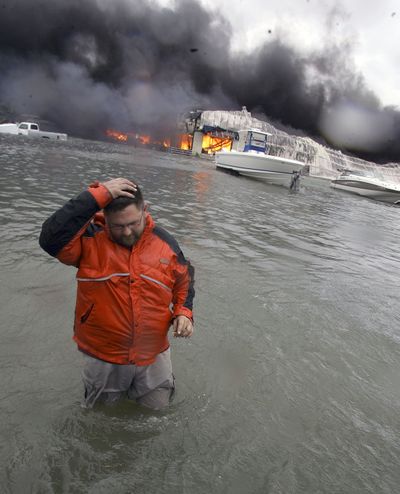Colossal Ike slams Texas
Hurricane floods Galveston; authorities fear catastrophe

GALVESTON, Texas – Punishing winds and waves from massive Hurricane Ike smashed into this low-lying barrier island Friday, flooding roads and providing a preview of what authorities predicted would be catastrophic damage to Galveston – and possibly Houston and other inland areas.
The storm, as big as Texas and packing winds of at least 110 mph, slammed into the coast somewhere near Galveston just after midnight today, Central time. Forecasters predicted that the storm’s “dirty side,” with the heaviest storm surge and highest winds, would batter Houston, the nation’s fourth-largest city.
There were fears that Ike would knock out power for up to 5.2 million customers and cause extensive damage across southeast Texas before heading into central Arkansas. Ike’s storm surge breached levees in Louisiana, flooding more than 1,800 homes.
Waves of roiling brown water from the Gulf of Mexico crashed against Galveston’s 17-foot sea wall, clogging streets with debris. Fast-rising Galveston Bay flooded access roads along Interstate 45, which connects Galveston to the mainland. Water lapped against the front steps of some homes and left streets impassable
“This is probably the biggest storm to hit the Texas coast in my lifetime, and I’m not a young bird,” Texas Gov. Rick Perry, 58, told KTRH radio. Perry predicted that Galveston and towns like Sabine Lake and Port Arthur would be left underwater.
The National Hurricane Center said Ike could strengthen into a Category 3 hurricane, with winds of 111 mph or higher, before making landfall. The center predicted a storm surge of 20 feet – 25 feet in some areas – and 5 to 10 inches of rain, if not more, in most areas.
About 600 miles across, Ike is one of the largest hurricanes in recent memory, taking up almost the entire northern half of the Gulf of Mexico.
If Ike is as bad as feared, the storm could travel up Galveston Bay and send a surge up the Houston Ship Channel and into the port of Houston. The port is the nation’s second-busiest, and is an economically vital complex of docks, pipelines, depots and warehouses that receives automobiles, consumer products, industrial equipment and other cargo from around the world and ships out vast amounts of petrochemicals and agricultural products.
The oil and gas industry was also closely watching Ike because it was headed straight for the nation’s biggest complex of refineries and petrochemical plants. Wholesale gasoline prices jumped to around $4.85 a gallon for fear of shortages.
By late afternoon, the hurricane center reported that water levels had risen 5 inches along the gulf’s northwestern coast. AccuWeather described “a massive wall of water being pushed through the gulf” toward the Texas coast. The storm surge breached levees and flooded more than 1,800 homes in Louisiana, and Gov. Bobby Jindal said more than 160 people had been rescued from flooding.
The U.S. Coast Guard was besieged by at least 200 panicked calls Friday from residents all along the coastline seeking help. Ninety-four people and four pets were rescued by helicopters before the aircraft were grounded because of winds. Residents climbed onto their rooftops to flag down rescuers, said Chief Warrant Officer Lionel Bryant in Katy, Texas.
“One person down on the coast said they were stranded with 24 other people,” Bryant said. “Our helicopters can only carry six people, along with the crew, if we really shove them in there.”
Houston, a city of 4 million, was boarded up and locked down late Friday. Parts of the city and surrounding areas were under curfew from 7 p.m. to 6 a.m. Most businesses were closed, and the streets were nearly empty except for police cars and emergency vehicles.
Authorities feared widespread flooding in the city. Ike could force water up the seven bayous that wind through Houston, inundating neighborhoods prone to flooding even during ordinary rainstorms.